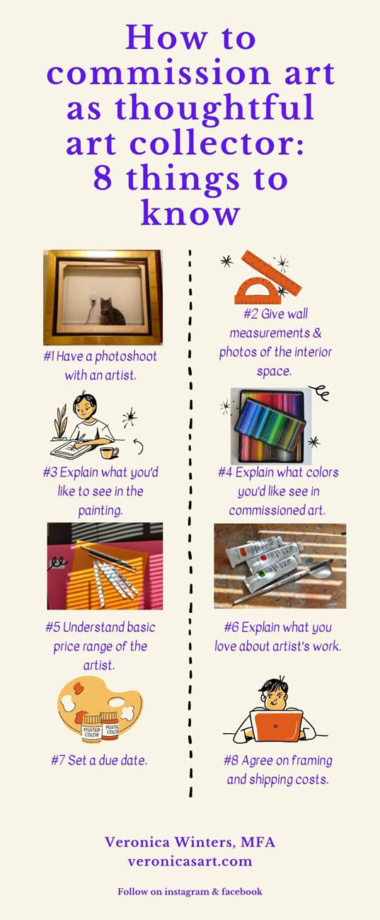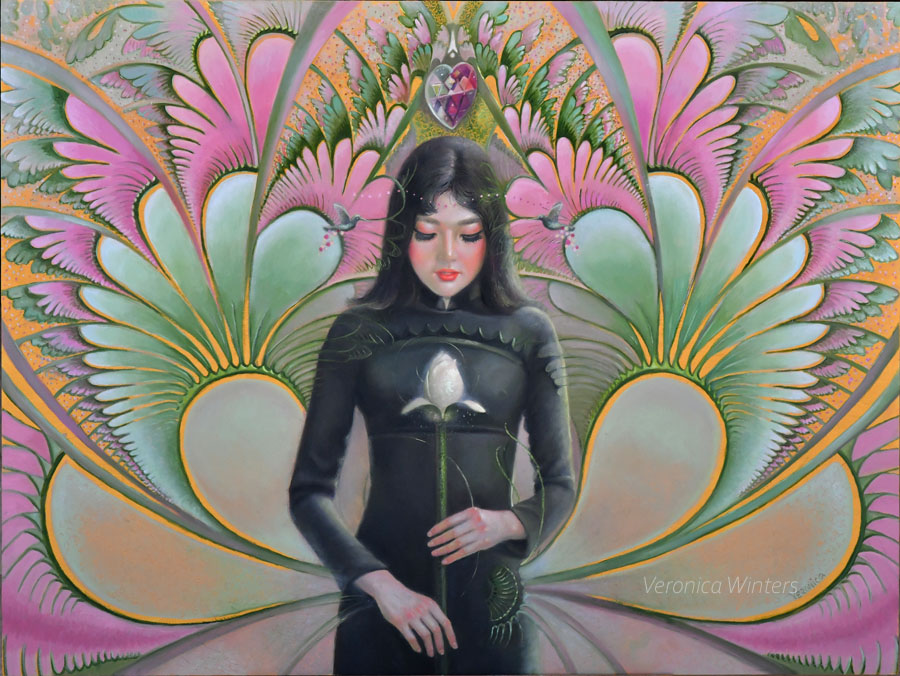It’s such a wonderful experience to hang a unique piece of art in your home or office! Art collecting is a great way to show who you are, create unique space and support contemporary artists!
If you’ve decided on a specific idea or want to commission a portrait painting you need to learn how to approach the artist you like. So what’s the right way of communicating your idea and understanding what the artist needs to produce a custom art piece? In this article I’d like to discuss what the artist needs from you in order to fulfill your commission.
How to commission art as thoughtful art collector
I’m going to assume that you pick your favorite artist and you know what he or she paints well. (You don’t want to ask for an abstract painting done by a figurative artist and such). You also know that the artist accepts commissions because many don’t. Finally you love the artist’s style so much so that you’re confident you want to have a custom painting created by this artist.

#1 Have a photoshoot with artist.
Most realist artists paint portraits from their references. In addition to that, some classically trained artists like to make at least one portrait study from life. This means that you must be available for a photoshoot as well as for a two-hour direct sketching by the artist.
A lot of artists try to work with the reference provided by the client but a big disadvantage to this is that most references are of poor quality or are not creative for the artist to work from. It makes a big difference if the artist creates art based on the image or if he/she just copies the image.
Personally, I’ve seen numerous pictures with poor lighting, busy backgrounds and blurry faces. What’s worse these pictures often capture the unflattering angle of a sitter. Most references are phone snapshots with distorted perspective and facial features! Expecting the artist to create a masterpiece from such a reference is too much to ask for. You might think and say that the artist can change this or that but it doesn’t quite work this way because artists copy what they see in the reference picture, making some adjustments only. When the artist takes the picture, he already creates art paying attention to the angle, light, color and so on.
What you need: You need to be available for a photoshoot with the artist.
What if it’s a reference of your girlfriend or a family member and you have no way of arranging a photoshoot? Pick the best photos possible with directional light, simple background and flattering, natural pose. Pictures must be of the highest resolution possible!

#2 Give wall measurements & photos of the interior space.
If you want to commission a site-specific artwork, you need to send pictures of the space to the artist and give measurements of the entire wall space and the size of art you’d like to have on the wall. Artists need to see the space to understand the surroundings because the artist can put some interior elements into commissioned art piece or advice you on a different size, format and color scheme.

Canvas format can be landscape, portrait or circular in most cases. It could also be a diptych, triptych or a vary narrow, long canvas. Oftentimes the art size is odd and the artist must either make a special order or stretch the canvas himself. It’s great if the canvas size is standard and fits the space perfectly because getting the art supplies and framing it is a lot easier. Standard sizes are 16×20, 18×24, 24×36, 36×48 inches and so on. Note that not every artist knows how to stretch canvases of odd sizes and it involves a lot of work to do it well.
#3 Explain what you’d like to see in the painting.
Remove the guesswork and say what you wish to see in the painting. Is it the beauty of a sunset? Is it a water reflection that you love? Is it a specific type of a house that you want to see in the painting? Give your ideas along with the references if you wish to commission a landscape, cityscape or a portrait.

#4 Explain what colors you’d like see in commissioned art.
Communicate what colors are important to you and tell the artist what you actually like in his/her work. The artist will emphasize your favorite elements and colors in a commissioned piece.
#5 Understand basic price range of the artist.
Understand basic price range of the artist by looking at his website or asking the artist in a direct message via Instagram. Pricing varies with experience, years in business, studio costs, materials, fame, museum or other notable shows, collections and awards, size and complexity of work. Painting figures (anatomy) is the hardest but creating a very delicate architectural piece could be as hard. Painting clouds would take much less time… In the past artists charged clients based on a number of figures present in the painting. Today we have such a great variety of art and styles that artists have a wide range of subject, theme and prices as a result.
If you’re interested in a commissioned piece by a well-known artist, galleries may handle the commissioned art process. Auctions could have a record of a price range of a famous artist.
Don’t expect to get a great deal by asking for a reduced fee. Usually artists charge a bit more to fulfill a specific commission. There is at least a 50% deposit for any artist to begin painting.
#6 Explain what you love about artist’s work.
Don’t be afraid to say what you want to have in a commissioned artwork and what you love about the artist’s work. Artists do try to accomplish and fulfill all requests. Knowing what attracts you to artist’s pieces is helpful because you can understand what you like and the artist can bring these features forward in your commissioned art piece.
Also know that the way you see and perceive yourself as a model can be very different from the artist’s perception of you creating a portrait painting. Therefore the final image may and would be different from your imagination. In order to be involved in the process, ask the artist to give you the final sketch of the painting to see the composition. Then ask for a semi-finished image or even a video call if you see something you want to fix in art. Note that many artists don’t like sharing work-in-progress shots because it’s so different from the final result, it could give a wrong impression. It depends how the artist works. My paintings are quite messy in the beginning and I don’t share them at all.
I must tell you that you need to let the artist do the work! Beautiful pieces emerge when the artist isn’t pressured to create art. If you loom over the artist, art may not materialize or look constricted and unresolved in comparison to his main body of work.
#7 Set a due date.
Agree on a deadline with the artist. While oil painting dries out in a couple of weeks, varnishing is recommended after 6 months! Acrylic painting could be ready for shipping almost as soon as it’s done.
#8 Agree on framing, shipping costs and sign a contract.
Do you want the artist to frame art for you or you prefer to do it yourself? What about shipping costs? Ideally you or the artist could draft a one-page document (an agreement) outlining the project and details, so there is little confusion or miscommunication involved.
What’s your experience commissioning a piece? Share.
Check out visionary art for sale at Veronicasart.com .
Follow on Instagram @veronicawintersart